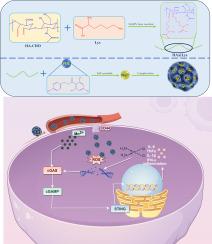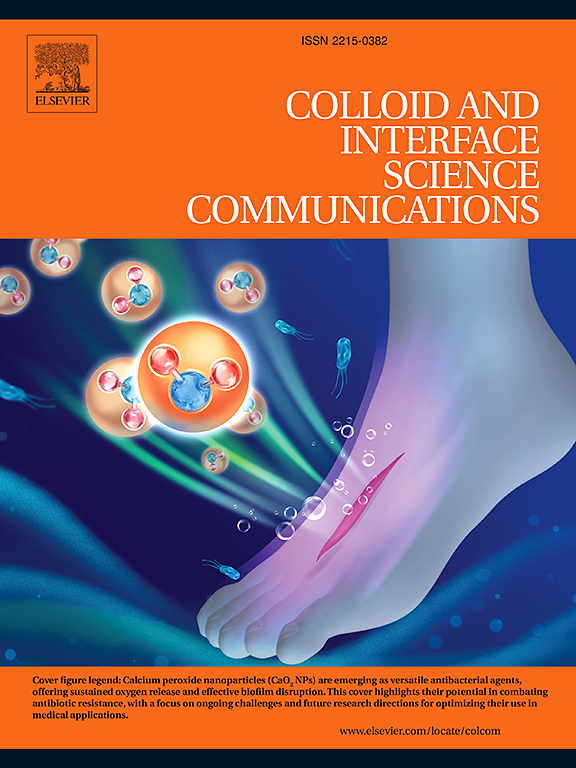Mn2+配位透明质酸修饰纳米颗粒用于输送根皮素:乳腺癌治疗
IF 4.7
3区 材料科学
Q2 CHEMISTRY, PHYSICAL
引用次数: 0
摘要
由于传统治疗方法的局限性,如耐药和全身毒性,乳腺癌仍然是一个全球性的健康挑战。本研究旨在通过构建氧化透明质酸(OHA)纳米粒子(OHA@Lys/PHL Mn2+)与根皮素(PHL)共载,开发一种新的协同化学免疫治疗平台。方法采用赖氨酸修饰的氧化透明质酸(OHA)包封PHL和Mn2+离子,构建纳米体系。在体外(4只T-1乳腺癌细胞)和体内(4只T-1荷瘤小鼠)评估其抗肿瘤效果,包括增殖抑制、诱导凋亡、活性氧(ROS)积累、DNA损伤、cGAS-STING通路激活和树突状细胞(DC)成熟。与顺铂(CDDP)联合治疗也进行了研究。ResultsOHA@Lys/PHL Mn2+对4个T-1细胞的细胞活力抑制率达到80.3%。与CDDP联合,进一步抑制细胞增殖,诱导细胞凋亡,增强ROS积累。在机制上,纳米系统诱导DNA双链损伤并激活cGAS-STING通路。在体内,OHA@Lys/PHL Mn2+单药治疗显示出显著的肿瘤抑制作用(46.4%,p <;0.001)。CDDP联合治疗达到了几乎完全的肿瘤抑制(抑制率为86.7%),并减少了肺转移。体内机制结果表明,纳米系统触发DNA损伤,激活cGAS-STING信号,显著促进DC成熟(对照组为48.5%比28.2%)。结论该策略为晚期乳腺癌的治疗提供了一种有前景的、可临床推广的方法。本文章由计算机程序翻译,如有差异,请以英文原文为准。

Mn2+-coordinated hyaluronic acid modified nanoparticles for phloretin delivery: Breast cancer treatment
Objective
Breast cancer remains a global health challenge due to limitations of conventional therapies, such as drug resistance and systemic toxicity. This study aimed to develop a novel synergistic chemo-immunotherapy platform by constructing Mn2+-coordinated oxidized hyaluronic acid (OHA)-based nanoparticles co-loaded with phloretin (PHL) (OHA@Lys/PHL Mn2+).
Methods
A nanosystem was engineered using oxidized hyaluronic acid (OHA) modified with lysine (Lys) to co-encapsulate PHL and Mn2+ ions. The anti-tumor efficacy was evaluated in vitro (4 T-1 breast cancer cells) and in vivo (4 T-1 tumor-bearing mice), including assessments of proliferation inhibition, apoptosis induction, reactive oxygen species (ROS) accumulation, DNA damage, cGAS-STING pathway activation, and dendritic cell (DC) maturation. Combination therapy with cisplatin (CDDP) was also investigated.
Results
OHA@Lys/PHL Mn2+ achieved 80.3 % cell viability inhibition on 4 T-1 cells. Combined with CDDP, it further suppressed proliferation, induced apoptosis, and enhanced ROS accumulation. Mechanistically, the nanosystem induced DNA double-strand damage and activated the cGAS-STING pathway. In vivo, OHA@Lys/PHL Mn2+ monotherapy showed significant tumor inhibition (46.4 %, p < 0.001). Combination with CDDP achieved near-complete tumor suppression (86.7 % inhibition) and reduced lung metastasis. The in vivo mechanism results indicated that nanosystem triggered DNA damage, activated cGAS-STING signaling, and significantly promoted DC maturation (48.5 % vs. 28.2 % in controls).
Conclusion
This strategy offers a promising and clinically translatable approach for advanced breast cancer treatment.
求助全文
通过发布文献求助,成功后即可免费获取论文全文。
去求助
来源期刊

Colloid and Interface Science Communications
Materials Science-Materials Chemistry
CiteScore
9.40
自引率
6.70%
发文量
125
审稿时长
43 days
期刊介绍:
Colloid and Interface Science Communications provides a forum for the highest visibility and rapid publication of short initial reports on new fundamental concepts, research findings, and topical applications at the forefront of the increasingly interdisciplinary area of colloid and interface science.
 求助内容:
求助内容: 应助结果提醒方式:
应助结果提醒方式:


